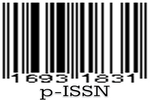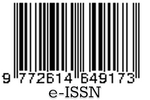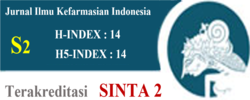Comparison of unfractionated heparin and fondaparinux in relation to the incidence of recurrent myocardial infarction
Abstract
Acute Myocardial Infarction (AMI) is a cardiovascular condition that involves necrosis of the heart muscle because of a decrease in blood supply to the heart caused by an obstruction of the coronary arteries. The prevalence of cardiac disease is 1.5% including AMI, and ranked 4th above all provinces in Indonesia. Anticoagulants are administered for the management of AMI treatment. Anticoagulants are treatments utilized to prevent thrombosis and reduce ischemic injury, preventing hemorrhage from developing in the heart's arteries and veins. Unfractionated heparin (UFH) and fondaparinux are both anticoagulants, that are utilized frequently in the treatment of AMI-EST patients. In decreasing the production of thrombin and preventing coagulation, unfractionated heparin, and fondaparinux can avoid death and recurrent myocardial infarction. The research was conducted as an observational study with retrospective data collection from medical records of inpatients diagnosed with acute transmural myocardial infarction of the anterior wall at Prof. Dr. Margono Soekarjo Purwokerto from January 2019 to December 2021. The chi-square test was used to examine the association between the type of anticoagulant therapy (unfractionated heparin or fondaparinux) and the incidence of recurrent myocardial infarction. The statistical analysis showed a significant association between the type of anticoagulant therapy and the incidence of recurrent myocardial infarction (p < 0.05). A higher proportion of patients treated with fondaparinux did not experience recurrent myocardial infarction compared to those treated with unfractionated heparin, suggesting that fondaparinux may be more effective in preventing recurrence.
References
[2] B. Budiman, R. Sihombing, and P. Pradina, “Hubungan dislipidemia, hipertensi dan diabetes melitus dengan kejadian ınfark miokard akut,” J. Kesehat. Masy. Andalas, vol. 10, no. 1, pp. 32–37, 2017, doi: 10.24893/jkma.v10i1.160.
[3] K. Thygesen, J. S. Alpert, A. S. Jaffe, B. R. Chaitman, J. J. Bax, D. A. Morrow, and H. D. White, "Fourth universal definition of myocardial infarction (2018)," Journal of the American College of Cardiology, vol. 72, no. 18, pp. 2231–2264, Oct. 30, 2018.
[4] Perhimpunan Dokter Spesialis Kardiovaskular Indonesia, Pedoman Tata Laksana Sindrom Koroner Akut. Jakarta: Perhimpunan Dokter Spesialis Kardiovaskular Indonesia, 2018.
[5] L. Tahaineh, A. Albsoul-Younes, M. Iflaifel, and I. Shehabi, “Evaluating unfractionated heparin fixed dosing protocol and establishing an ınstitutional therapeutic range for UFH in Hospital setting in Jordan,” Clin. Appl. Thromb., vol. 20, no. 1, pp. 73–77, 2014, doi: 10.1177/1076029612458722
[6] E. N. C. Onwordi, A. Gamal, and A. Zaman, “Anticoagulant therapy for acute coronary syndromes,” Interv. Cardiol. Rev. Res. Resour., vol. 13, no. 2, pp. 87–92, 2018, doi: 10.15420/icr.2017:26:1.
[7] C. A. Thompson, Textbook of Cardiovascular Intervention. London: Springer London, 2014.
[8] I. H. Jaffrey and J. I. Weitz, Antithrombotic Drugs in Hematology. Elsevier, 2018.
[9] Committee for Medical Products, Guideline on clinical ınvestigation of new medicinal products for the treatment of acute coronary syndrom. European Medicines Agency, 2017.
[10] L. De Luca, M. Uguccioni, E. Natale, M. Pugliese, A. Terranova, et al., “Effectiveness of fondaparinux vs unfractionated heparin following percutaneous coronary ıntervention in survivors of out-of-Hospital Cardiac arrest due to acute myocardial ınfarction.,” Eur. J. Clin. Pharmacol., vol. 77, no. 10, pp. 1563–1567, Oct. 2021, doi: 10.1007/s00228-021-03152-7
[11] S. Sharma, S. Swamy, A. Bhambhani, and P. Nadig, “Adverse drug reactions attributed to fondaparinux and unfractionated heparin in cardiovascular care unit: An observational prospective pilot study in a Tertiary Care Hospital.,” J. Pharm. Bioallied Sci., vol. 10, no. 2, pp. 90–95, 2018, doi: 10.4103/JPBS.JPBS_17_18.
[12] E. R. C. Millett, S. A. E. Peters, and M. Woodward, “Sex differences in risk factors for myocardial ınfarction: cohort study of UK Biobank Participants,” Br. Med. J., vol. 363, no. 42, pp. 1–11, 2018, doi: 10.1136/bmj.k4247
[13] Z. Gao, Z. Chen, A. Sun, and X. Deng, “Gender differences in cardiovascular disease,” Med. Nov. Technol. Devices, vol. 4, no. 2, pp. 1–4, 2019, doi: 10.1016/j.medntd.2019.100025
[14] I. Ilic and M. Ilic, “Risk factors for myocardial ınfarction in women and men: A case-control study,” Biol. Life Sci. Forum, vol. 9, no. 1, pp. 1–6, 2021, doi: 10.3390/ECCM-10876.
[15] D. J. Campbell, “Why do men and women differ in their risk of myocardial ınfarction?,” European Heart Journal, vol. 29, no. 7. England, pp. 835–836, Apr. 2008. doi: 10.1093/eurheartj/ehn074.
[16] A. A. J. Khaznadar and R. Wahid Salh, “Impact of age on risk factors and clinical manifestations of acute coronary syndrome: Observations from the coronary care unit of sulaimani, Iraq,” Hosp. Pract. Res., vol. 5, no. 1, pp. 28–34, 2020, doi: 10.34172/hpr.2020.06.
[17] Kementerian Kesehatan Republik Indonesia, “Survey Kesehatan Indonesia,” Jakarta, 2023.
[18] F. Violi, E. Z. Soliman, P. Pignatelli, and D. Pastori, “Atrial fibrillation and myocardial ınfarction: A systematic review and appraisal of pathophysiologic mechanisms,” J. Am. Heart Assoc., vol. 5, no. 5, pp. 1–13, May 2016, doi: 10.1161/JAHA.116.003347.
[19] H. Y. Lee, P. S. Yang, T. H. Kim, J. S. Uhm, H. N. Pak, M. H. Lee, and B. Joung, et al., “Atrial fibrillation and the risk of myocardial ınfarction: A nation-wide propensity-matched study,” Sci. Rep., vol. 7, no. 1, pp. 1–8, 2017, doi: 10.1038/s41598-017-13061-4.
[20] H. S. Lim et al., “Effect of atrial fibrillation on atrial thrombogenesis in humans: Impact of rate and rhythm,” J. Am. Coll. Cardiol., vol. 61, no. 8, pp. 852–860, Feb. 2013, doi: 10.1016/j.jacc.2012.11.046.
[21] J. Cui, Y. Liu, Y. Li, F. Xu, and Y. Liu, “Type 2 diabetes and myocardial ınfarction: Recent clinical evidence and perspective,” Front. Cardiovasc. Med., vol. 8, p. 644189, 2021, doi: 10.3389/fcvm.2021.644189.
[22] T. R. Einarson, A. Acs, C. Ludwig, and U. H. Panton, “Prevalence of cardiovascular disease in type 2 diabetes: A systematic literature review of scientific evidence from across the world in 2007-2017,” Cardiovasc. Diabetol., vol. 17, no. 1, p. 83, Jun. 2018, doi: 10.1186/s12933-018-0728-6.
[23] V. Rathore, N. Singh, and R. K. Mahat, “Risk factors of acute myocardial ınfarction: A review,” Eurasian J. Med. Investig., vol. 2, no. 1, pp. 1–7, 2018, doi: 10.14744/ejmi.2018.76486.
[24] K. Göbel, S. Eichler, H. Wiendl, T. Chavakis, C. Kleinschnitz, and S. G. Meuth, “The coagulation factors fibrinogen, thrombin, and factor xıı in ınflammatory disorders-a systematic review,” Front. Immunol., vol. 9, p. 1731, 2018, doi: 10.3389/fimmu.2018.01731.
[25] Y. Hernaningsih and E. B. Maulidan, “Examination of laboratory for monitoring heparin anticoagulant therapy.” pp. 1–21, 2020. doi: 10.5772/intechopen.88401.
[26] B. Ibanez et al., “2017 ESC guidelines for the management of acute myocardial ınfarction in patients presenting with st-segment elevation: The task force for the management of acute myocardial ınfarction in patients presenting with st-segment elevation of The European Socie,” Eur. Heart J., vol. 39, no. 2, pp. 119–177, Jan. 2018, doi: 10.1093/eurheartj/ehx393.
[27] A. Gechlik, J. Espinosa, A. Lucerna, and K. Patel, “A Brief literature review on heparin: To bolus or not to bolus, that ıs the question,” Circulation, vol. 103, no. 24, pp. 2994–3018, 2022, doi: 10.1161/01.CIR.103.24.2994.
[28] S. G. Stone et al., “Incidence, Predictors, and ımplications of reinfarction after primary percutaneous coronary ıntervention in st-segment-elevation myocardial ınfarction: the harmonizing outcomes with revascularization and stents in acute myocardial ınfarction trial,” Circulation, vol. 7, no. 4, pp. 543–551, Aug. 2014, doi: 10.1161/CIRCINTERVENTIONS.114.001360.
[29] Astuti, L. W., Fajriah, S., Rilawati, F., and Istiqomah, N., “Effectiveness of anticoagulants in Reducing D-Dimer Levels in COVID-19 Patients: A restrospective Study,” Indonesian Journal of Pharmaceutical Education (e-Journal), vol. 5, no. 1, pp. 95–103, 2025, doi: doi: 10.37311/ijpe.v5i1.30233
[30] M. Z. Yan, M. Yang, and C. L. Lai, “Post covid-19 syndrome comprehensıve asessment: from clinical diagnosis to imagıng and bıochemıcal-guıded dıagnosıs and management,” MDPI., vol. 15, no. 2, pp. 1-26, 2023, doi: 10.3390/v15020533.
[31] Azizah, N. F., Faizah, R. N., Primasanti, D., Prihatini, I.K., and Romadhian, I. G, “Efektifitas penggunaan enoxaparin dan fondaparinux sebagai antikoagulan pada pasien COVID-19 di RSUD Sidoarjo,” Majalah Farmasetik., vol. 8, no. 1, pp. 57–64, 2022, doi: 10.22146/farmaseutik.v18i1.71913
[32] Anonim. 2019. https://icd.who.int/browse10/2019/en, (accessd on 13 Nov 2025).

This work is licensed under a Creative Commons Attribution-NonCommercial-ShareAlike 4.0 International License.
Licencing
All articles in Jurnal Ilmu Kefarmasian Indonesia are an open-access article, distributed under the terms of the Creative Commons Attribution-NonCommercial-ShareAlike 4.0 International License which permits unrestricted non-commercial used, distribution and reproduction in any medium.
This licence applies to Author(s) and Public Reader means that the users mays :
- SHARE:
copy and redistribute the article in any medium or format - ADAPT:
remix, transform, and build upon the article (eg.: to produce a new research work and, possibly, a new publication) - ALIKE:
If you remix, transform, or build upon the article, you must distribute your contributions under the same license as the original. - NO ADDITIONAL RESTRICTIONS:
You may not apply legal terms or technological measures that legally restrict others from doing anything the license permits.
It does however mean that when you use it you must:
- ATTRIBUTION: You must give appropriate credit to both the Author(s) and the journal, provide a link to the license, and indicate if changes were made. You may do so in any reasonable manner, but not in any way that suggests the licensor endorses you or your use.
You may not:
- NONCOMMERCIAL: You may not use the article for commercial purposes.
This work is licensed under a Creative Commons Attribution-NonCommercial-ShareAlike 4.0 International License.




 Tools
Tools





















